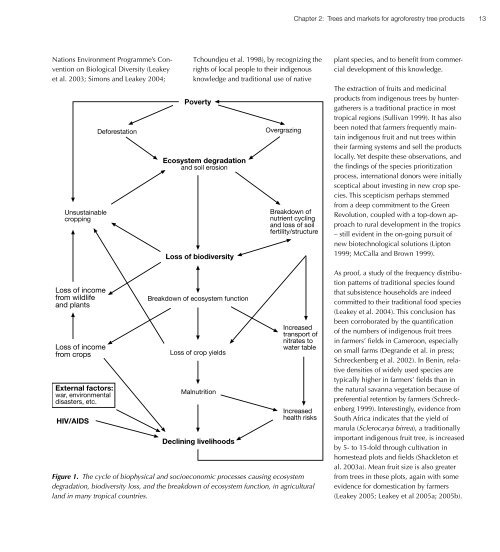The challenge of HIV/AIDS: Where does agroforestry fit in? - World ...
The challenge of HIV/AIDS: Where does agroforestry fit in? - World ...
The challenge of HIV/AIDS: Where does agroforestry fit in? - World ...
You also want an ePaper? Increase the reach of your titles
YUMPU automatically turns print PDFs into web optimized ePapers that Google loves.
Chapter 2: Trees and markets for agr<strong>of</strong>orestry tree products13Nations Environment Programme’s Conventionon Biological Diversity (Leakeyet al. 2003; Simons and Leakey 2004;Unsusta<strong>in</strong>ablecropp<strong>in</strong>gLoss <strong>of</strong> <strong>in</strong>comefrom wildlifeand plantsLoss <strong>of</strong> <strong>in</strong>comefrom cropsExternal factors:war, environmentaldisasters, etc.<strong>HIV</strong>/<strong>AIDS</strong>DeforestationTchoundjeu et al. 1998), by recogniz<strong>in</strong>g therights <strong>of</strong> local people to their <strong>in</strong>digenousknowledge and traditional use <strong>of</strong> nativePovertyEcosystem degradationand soil erosionLoss <strong>of</strong> biodiversityBreakdown <strong>of</strong> ecosystem functionLoss <strong>of</strong> crop yieldsMalnutritionDecl<strong>in</strong><strong>in</strong>g livelihoodsOvergraz<strong>in</strong>gBreakdown <strong>of</strong>nutrient cycl<strong>in</strong>gand loss <strong>of</strong> soilfertility/structureIncreasedtransport <strong>of</strong>nitrates towater tableIncreasedhealth risksFigure 1. <strong>The</strong> cycle <strong>of</strong> biophysical and socioeconomic processes caus<strong>in</strong>g ecosystemdegradation, biodiversity loss, and the breakdown <strong>of</strong> ecosystem function, <strong>in</strong> agriculturalland <strong>in</strong> many tropical countries.plant species, and to bene<strong>fit</strong> from commercialdevelopment <strong>of</strong> this knowledge.<strong>The</strong> extraction <strong>of</strong> fruits and medic<strong>in</strong>alproducts from <strong>in</strong>digenous trees by huntergatherersis a traditional practice <strong>in</strong> mosttropical regions (Sullivan 1999). It has alsobeen noted that farmers frequently ma<strong>in</strong>ta<strong>in</strong><strong>in</strong>digenous fruit and nut trees with<strong>in</strong>their farm<strong>in</strong>g systems and sell the productslocally. Yet despite these observations, andthe f<strong>in</strong>d<strong>in</strong>gs <strong>of</strong> the species prioritizationprocess, <strong>in</strong>ternational donors were <strong>in</strong>itiallysceptical about <strong>in</strong>vest<strong>in</strong>g <strong>in</strong> new crop species.This scepticism perhaps stemmedfrom a deep commitment to the GreenRevolution, coupled with a top-down approachto rural development <strong>in</strong> the tropics– still evident <strong>in</strong> the on-go<strong>in</strong>g pursuit <strong>of</strong>new biotechnological solutions (Lipton1999; McCalla and Brown 1999).As pro<strong>of</strong>, a study <strong>of</strong> the frequency distributionpatterns <strong>of</strong> traditional species foundthat subsistence households are <strong>in</strong>deedcommitted to their traditional food species(Leakey et al. 2004). This conclusion hasbeen corroborated by the quantification<strong>of</strong> the numbers <strong>of</strong> <strong>in</strong>digenous fruit trees<strong>in</strong> farmers’ fields <strong>in</strong> Cameroon, especiallyon small farms (Degrande et al. <strong>in</strong> press;Schreckenberg et al. 2002). In Ben<strong>in</strong>, relativedensities <strong>of</strong> widely used species aretypically higher <strong>in</strong> farmers’ fields than <strong>in</strong>the natural savanna vegetation because <strong>of</strong>preferential retention by farmers (Schreckenberg1999). Interest<strong>in</strong>gly, evidence fromSouth Africa <strong>in</strong>dicates that the yield <strong>of</strong>marula (Sclerocarya birrea), a traditionallyimportant <strong>in</strong>digenous fruit tree, is <strong>in</strong>creasedby 5- to 15-fold through cultivation <strong>in</strong>homestead plots and fields (Shackleton etal. 2003a). Mean fruit size is also greaterfrom trees <strong>in</strong> these plots, aga<strong>in</strong> with someevidence for domestication by farmers(Leakey 2005; Leakey et al 2005a; 2005b).




![MNC_00_Modau [Compatibility Mode].pdf](https://img.yumpu.com/51432208/1/190x146/mnc-00-modau-compatibility-modepdf.jpg?quality=85)











